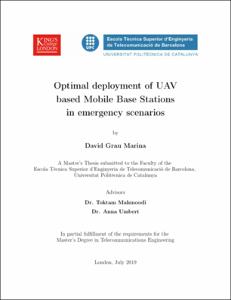Mostra el registre d'ítem simple
Optimal deployment of UAV based Mobile Base Stations in emergency scenarios
| dc.contributor | Mahmoodi, Toktam |
| dc.contributor | Umbert Juliana, Anna |
| dc.contributor.author | Grau Marina, David |
| dc.contributor.other | Universitat Politècnica de Catalunya. Departament de Teoria del Senyal i Comunicacions |
| dc.date.accessioned | 2019-10-25T13:01:37Z |
| dc.date.available | 2019-10-25T13:01:37Z |
| dc.date.issued | 2019-07 |
| dc.identifier.uri | http://hdl.handle.net/2117/170891 |
| dc.description | In this traineeship, we will investigate the main challenges when a car is merging onto a lane of cars in a safe and efficient manner. |
| dc.description.abstract | In emergency scenarios where ground base stations are no longer available, Unmanned aerial vehicles (UAVs) based mobile base stations (MBS) can provide a good solution to provide coverage to the ground terminals in the affected area thanks to their versatility and affordability. The objective of this work is to study how these MBS can be deployed in the affected area minimizing the number of devices deployed at the same time than maximizing the coverage of every single user. We based our placement on an spiral algorithm path from the edge users towards the area center by minimizing the power consumption of each device and the interference in the MBS network. Once the MBS is already placed, we optimized the power consumption by making use of multi-antenna techniques to generate directional beams introducing the Non-Orthogonal Multiple Access (NOMA) technique, a promising technology in the upcoming fifth generation (5G). Finally, numerical results show how our algorithm improves the performance of the previous one in terms of quality of service (QoS) of the ground user. |
| dc.language.iso | eng |
| dc.publisher | Universitat Politècnica de Catalunya |
| dc.rights | S'autoritza la difusió de l'obra mitjançant la llicència Creative Commons o similar 'Reconeixement-NoComercial- SenseObraDerivada' |
| dc.rights.uri | http://creativecommons.org/licenses/by-nc-nd/3.0/es/ |
| dc.subject | Àrees temàtiques de la UPC::Enginyeria de la telecomunicació |
| dc.subject.lcsh | Mobile communication systems |
| dc.subject.lcsh | Antennas (Electronics) |
| dc.subject.other | UAV |
| dc.subject.other | drone |
| dc.subject.other | air-to-ground communication |
| dc.subject.other | drone placement |
| dc.subject.other | user coverage |
| dc.subject.other | 5G |
| dc.subject.other | NOMA |
| dc.subject.other | mmWave |
| dc.title | Optimal deployment of UAV based Mobile Base Stations in emergency scenarios |
| dc.title.alternative | Optimal deployment of UAV based Mobile Base Stations in emergency scenarios |
| dc.type | Master thesis |
| dc.subject.lemac | Comunicacions mòbils, Sistemes de |
| dc.subject.lemac | Antenes (Electrònica) |
| dc.identifier.slug | ETSETB-230.144478 |
| dc.rights.access | Open Access |
| dc.date.updated | 2019-07-23T05:51:12Z |
| dc.audience.educationlevel | Màster |
| dc.audience.mediator | Escola Tècnica Superior d'Enginyeria de Telecomunicació de Barcelona |
| dc.audience.degree | MÀSTER UNIVERSITARI EN ENGINYERIA DE TELECOMUNICACIÓ (Pla 2013) |


